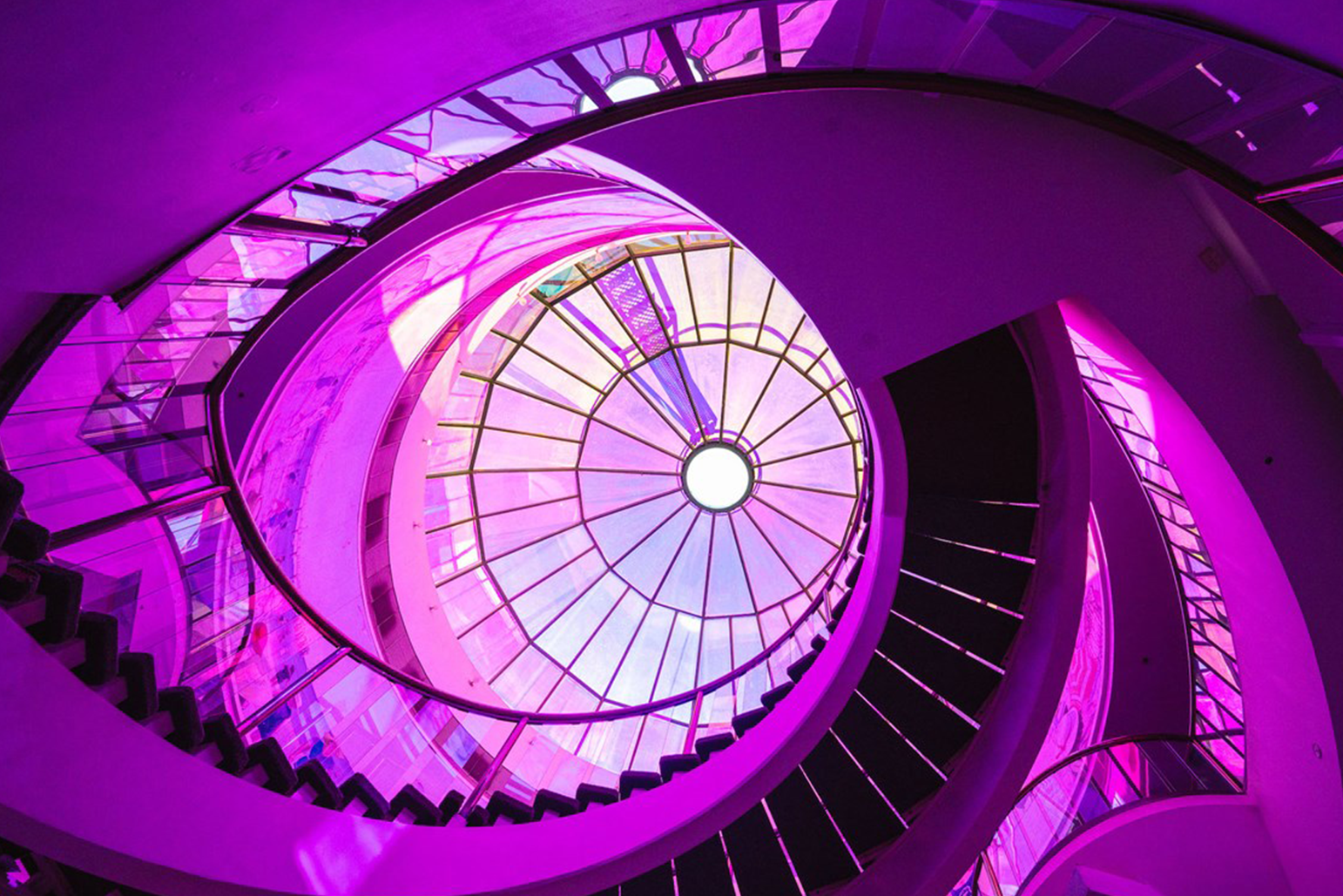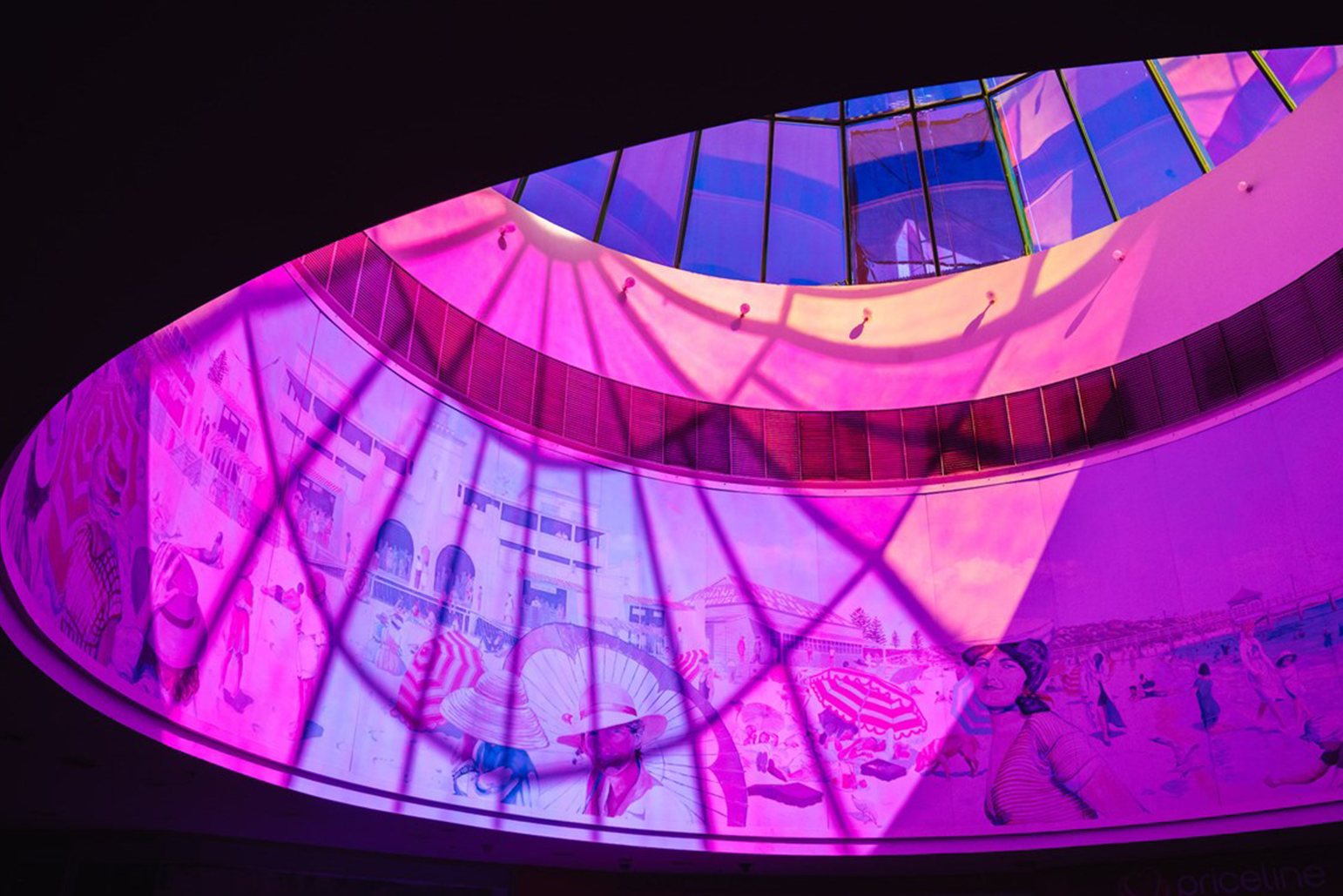


It is hard not to think of Rebecca Baumann’s Light Event as the perfect coda to Linda Tegg’s Wetland. In Wetland, the desolate food court of Carillon City is swamped and filled with plant life that would have grown there prior to colonisation—Tegg’s arrangement guided by Balladong Whadjuk bush medicine expert Vivienne Hansen. Wetland is eerie and arresting, nestled among the relics of the food court. Meandering across the boardwalk, one exits Wetland into Carillon City’s glass atrium, the site of Baumann’s Light Event. A recent editorial in The Guardian remarked of feeling ‘a pang of sadness looking up at a mural depicting sunbathers at Cottesloe beach in the 1930s, glowing under Rebecca’s orange and magenta light, and realising it might be the last time I see it’.[1] There is something truly unsettling—even uncanny—about Light Event. Sitting in the magenta atrium, the ambience unusually shrine-like, I wondered why this building seems so quintessentially “Perth”—it is hardly an unique building, yet it appears to perfectly embody the bleak industriousness and ‘80s ugliness that is synonymous with a particular moment in Perth’s cultural history. Now set to be redeveloped by Andrew Forrest’s property division Fiveight, both Wetland and Light Event are timely “interventions”.[2]
Of course, before I experienced Baumann’s work in person, I had already seen it shared on several Instagram stories. Initially, Light Event seemed to me to be Perth Festival’s “Instagrammable art” moment—and in many respects it is. I doubt that the social media appeal of the work is of any real concern to Baumann. Yet, given its irresistibly “selfie inducing” nature, considering this aspect is inevitable, if not inescapable. On the one hand, art has always had a social function, signalling various qualities about its owner (capital, land ownership, nobility, social status, etc.). Today, this signalling is also made possible by social media, through which we “collect”, “own”, and “display” our experience of art. Instagrammable art has perhaps a “democratising” influence on the artworld. On the other hand, Instagrammable art sees art removed from our once more personal, interior lives. Rather than serving to enrich our experiences of intimate or domestic settings, art is most commonly consumed through temporal participation.[3] But rather than some artworld calamity, this is just a logical extension brought on by our inescapable post-internet paradigm shift. The impact this all has on works such as Baumann’s is difficult to determine. However, to suggest that the repeated proliferation of the same purple atrium pic taken by innumerable Instagrammers is of no significance seems equally impossible.
Social media has had much the same impact on art criticism as it has had on art: everyone's a critic.[4] All the while, the authority of the conventional critic is on the ebb, at least in the ways which it used to be perceived. Through social media algorithms, like-for-like opinions are sifted, funnelled together, and put in dialogue to create echo (torture) chambers. This kind of commentary on social media’s function—a milquetoast definition—proffers a virtual hellscape. In a situation where opinions can be distributed based on their agreeableness, that a “letter to the editor” section once existed seems like a far-flung fantasy. Perhaps critics are simply becoming more regimented, clustered into discursive coteries. However, this does not seem to be quite the reality—yet. In the face of a pessimistic future, where healthy, pluralistic discourse is stymied by the very medium through which it occurs, the considered critic seems left with one option: to embrace polemical writing, to argue the counterfactual, and to present clarifying arguments. They may as well. It sounds more interesting than retreading the self-indulgent confessionals of lived experience that are favoured by some senior millennial critics.[5] And certainly more interesting than a totally private response, which contributes less, perhaps nothing, to critical discourse. Without doubt, it seems to me that the answer is for critics to seek a new discursive directness (something for another article).
But for now, back to Baumann and that strange purple atrium that made me feel uneasy and sad. Having been inaccessible for some time, Baumann’s “intervention” is not really an intervention at all. Instead, it is a “repurposing”, with the disused location accessible because of the work—the work is now the only reason to visit. Any sense of intervention plays on our collective memories of Carillon City. Or perhaps, to go one step further, that the work is in Carillon City doesn’t matter at all. Instead, the work is a monument to the sadness of forsaken neoliberal shopping centres. An elevation of basking in the static ambience of a disused site. What is successful about Light Event is how it prods at the raw nerve of nostalgia in a way that is simple, sincere, and uncomplicated—with colour and light. However, beyond the evocation of eerie melancholy, the work stakes no further claims.
Footnotes:
1. Available here: www.theguardian.com/culture/2024/feb/22/perth-festival-carillon-city-shopping-centre-wetland
2. Billed as an “intervention” in www.perthfestival.com.au/events/rebecca-baumann
3. Witnessed both in the excesses of the deregulated art market and the rise of grant funded art projects and festivals being the commonplace means through which the working class “experience” art.
4. A current example is the sudden rise of Taylor Morrison, an Instagrammer who posts video “crits” of individual artworks on his channel @weopen, which now has nearly 23,000 followers.
5. Save it for the memoir folks.
Image credits: Rebecca Baumann, 'Light Event', 2024, installation view. Photo Louise Coghill
Of course, before I experienced Baumann’s work in person, I had already seen it shared on several Instagram stories. Initially, Light Event seemed to me to be Perth Festival’s “Instagrammable art” moment—and in many respects it is. I doubt that the social media appeal of the work is of any real concern to Baumann. Yet, given its irresistibly “selfie inducing” nature, considering this aspect is inevitable, if not inescapable. On the one hand, art has always had a social function, signalling various qualities about its owner (capital, land ownership, nobility, social status, etc.). Today, this signalling is also made possible by social media, through which we “collect”, “own”, and “display” our experience of art. Instagrammable art has perhaps a “democratising” influence on the artworld. On the other hand, Instagrammable art sees art removed from our once more personal, interior lives. Rather than serving to enrich our experiences of intimate or domestic settings, art is most commonly consumed through temporal participation.[3] But rather than some artworld calamity, this is just a logical extension brought on by our inescapable post-internet paradigm shift. The impact this all has on works such as Baumann’s is difficult to determine. However, to suggest that the repeated proliferation of the same purple atrium pic taken by innumerable Instagrammers is of no significance seems equally impossible.
Social media has had much the same impact on art criticism as it has had on art: everyone's a critic.[4] All the while, the authority of the conventional critic is on the ebb, at least in the ways which it used to be perceived. Through social media algorithms, like-for-like opinions are sifted, funnelled together, and put in dialogue to create echo (torture) chambers. This kind of commentary on social media’s function—a milquetoast definition—proffers a virtual hellscape. In a situation where opinions can be distributed based on their agreeableness, that a “letter to the editor” section once existed seems like a far-flung fantasy. Perhaps critics are simply becoming more regimented, clustered into discursive coteries. However, this does not seem to be quite the reality—yet. In the face of a pessimistic future, where healthy, pluralistic discourse is stymied by the very medium through which it occurs, the considered critic seems left with one option: to embrace polemical writing, to argue the counterfactual, and to present clarifying arguments. They may as well. It sounds more interesting than retreading the self-indulgent confessionals of lived experience that are favoured by some senior millennial critics.[5] And certainly more interesting than a totally private response, which contributes less, perhaps nothing, to critical discourse. Without doubt, it seems to me that the answer is for critics to seek a new discursive directness (something for another article).
But for now, back to Baumann and that strange purple atrium that made me feel uneasy and sad. Having been inaccessible for some time, Baumann’s “intervention” is not really an intervention at all. Instead, it is a “repurposing”, with the disused location accessible because of the work—the work is now the only reason to visit. Any sense of intervention plays on our collective memories of Carillon City. Or perhaps, to go one step further, that the work is in Carillon City doesn’t matter at all. Instead, the work is a monument to the sadness of forsaken neoliberal shopping centres. An elevation of basking in the static ambience of a disused site. What is successful about Light Event is how it prods at the raw nerve of nostalgia in a way that is simple, sincere, and uncomplicated—with colour and light. However, beyond the evocation of eerie melancholy, the work stakes no further claims.
Footnotes:
1. Available here: www.theguardian.com/culture/2024/feb/22/perth-festival-carillon-city-shopping-centre-wetland
2. Billed as an “intervention” in www.perthfestival.com.au/events/rebecca-baumann
3. Witnessed both in the excesses of the deregulated art market and the rise of grant funded art projects and festivals being the commonplace means through which the working class “experience” art.
4. A current example is the sudden rise of Taylor Morrison, an Instagrammer who posts video “crits” of individual artworks on his channel @weopen, which now has nearly 23,000 followers.
5. Save it for the memoir folks.
Image credits: Rebecca Baumann, 'Light Event', 2024, installation view. Photo Louise Coghill
